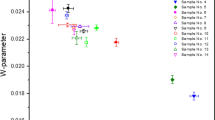Abstract
In this study we investigated the feasibility of using photon activation analysis (PAA) for the identification and individualization of crime scene evidence. We prepared six samples of stainless steel knife blades belonging to same or different knives and activated them with bremsstrahlung photons produced by a 30 MeV electron beam. A number of alloying elements and impurities were identified by gamma-spectroscopy. Comparing the ratios of concentrations of Ti, Cr, As, Co, and Ni, allowed us to easily attribute the samples. While more work is needed to optimize the analytical method and improve its sensitivity, we believe PAA can be successfully used for non-destructive evidence materials identification.




Similar content being viewed by others
References
Roux C, Taudte RV, Lennard C (2013) X-Ray fluorescence in forensic science. Encycl Anal Chem. doi:10.1002/9780470027318.a1124.pub2
Brinsko KM (2010) Optical characterization of some modern “eco-friendly” fibers. J Forensic Sci 55:915–923. doi:10.1111/j.1556-4029.2010.01369.x
Petraco N, Kubic TA, Petraco NDK (2008) Case studies in forensic soil examinations. Forensic Sci Int 178:e23–e27. doi:10.1016/j.forsciint.2008.03.008
Zieba-Palus J, Borusiewicz R, Kunicki M (2008) PRAXIS-combined mu-Raman and mu-XRF spectrometers in the examination of forensic samples. Forensic Sci Int 175:1–10. doi:10.1016/j.forsciint.2007.04.230
Berendes A, Neimke D, Schumacher R, Barth M (2006) A versatile technique for the investigation of gunshot residue patterns on fabrics and other surfaces: m-XRF. J Forensic Sci 51:1085–1090. doi:10.1111/j.1556-4029.2006.00225.x
Reid L, Chana K, Bond JW et al (2010) Stubs versus swabs? A comparison of gunshot residue collection techniques. J Forensic Sci 55:753–756. doi:10.1111/j.1556-4029.2010.01332.x
Audette RJ, PRF E (1979) Rapid, systematic, and comprehensive classification system for the identification and comparison of motor vehicle paint samples, 1—the nature and scope of the classification system. J Forensic Sci 24:790–807
Cook R, Paterson MD (1978) New techniques for the identification of microscopic samples of textile fibres by infrared spectroscopy. Forensic Sci Int 12:237–243. doi:10.1016/0379-0738(78)90009-9
Williams RL, Kemp GS, Totty RN et al (1983) Analysis of photocopying toners by infrared spectroscopy. Forensic Sci Int 22:85–95. doi:10.1016/0379-0738(83)90122-6
Virkler K, Lednev IK (2009) Blood species identification for forensic purposes using Raman spectroscopy combined with advanced statistical analysis. Anal Chem 81:7773–7777. doi:10.1021/ac901350a
Suzuki EM, Gresham WR (1986) Forensic science applications of diffuse reflectance infrared Fourier transform spectroscopy (DRIFTS): II. Direct analysis of some tablets, capsule powders, and powders. J Forensic Sci 31:11908J. doi:10.1520/JFS11908J
Grant DM, Peters CA, Grant DM, Peters CA (2000) Atomic spectroscopy for forensic applications. Encycl Anal Chem. doi 10(1002/9780470027318):a1110
Yinon J (1995) Forensic applications of mass spectrometry. CRC Press, Boca Raton
Council NR (2009) Strengthening forensic science in the United States. doi:10.17226/12589
Sun ZJ, Wells DP, Segebade C et al (2012) A provenance study of coffee by photon activation analysis. J Radioanal Nucl Chem 296:293–299. doi:10.1007/s10967-012-2021-6
Segebade C (2013) Edward’s sword? A non-destructive study of a medieval king’s sword. AIP Conf Proc 1525:417. doi:10.1063/1.4802361
Galatanu V, Engelmann C (1982) Analyse multielementaire des cheveux par photoactivation nucleaire. J Radioanal Chem 74:161–180. doi:10.1007/BF02520369
Kanda Y, Oikawa T, Niwaguchi T (1980) Multi-element determinations of trace elements in glass by instrumental photon activation analysis. Anal Chim Acta 121:157–163
Settle DM (1967) Neutron activation and photonuclear activation analysis of glass samples. Proceedings of First International Conference on Forensic Activation Analysis, San Diego
Voigt AF, Abu-Samra A (1965) Analysis of a Damascus steel by neutron and gamma-activation. Rep. IS-1105, Institute for Atomic research and Department of Chemistry and Nuclear Engineering, Iowa State University, Ames, IA, USA
Segebade C, Weise H-P, Lutz GJ, Adams F (1988) Photon activation analysis. Anal Chim Acta 211:339
Segebade C, Berger A (2008) Photon activation analysis. Encycl Anal Chem. doi:10.1002/9780470027318.a6211.pub2
Starovoitova V, Segebade C (2016) High intensity photon sources for activation analysis. J Radioanal Nucl Chem. doi:10.1007/s10967-016-4899-x
Acknowledgments
The authors are thankful to Professor Doug Wells for helpful suggestions and discussions and to the Idaho Accelerator Center staff for their support in conducting the experiment.
Author information
Authors and Affiliations
Corresponding author
Rights and permissions
About this article
Cite this article
Starovoitova, V.N., Segebade, C. Photon activation analysis as a tool for evidentiary sample identification: a feasibility study. J Radioanal Nucl Chem 311, 611–615 (2017). https://doi.org/10.1007/s10967-016-4964-5
Received:
Published:
Issue Date:
DOI: https://doi.org/10.1007/s10967-016-4964-5




